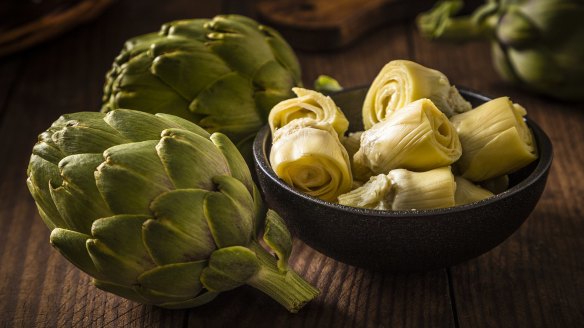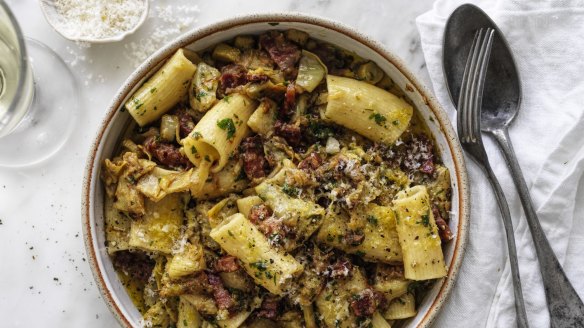Artichokes: Everything you need to know

What are they?
Delicious but a little fiddly, artichokes are the edible flower buds of a type of thistle. Originally from Sicily, they grow across the Mediterranean and northern Africa. About the size of an adult fist, artichokes are covered in bracts, which look like fleshy scales. These conceal the "choke", the fuzzy stamen at the base of the flower, which are inedible. The fleshy parts of the bracts are edible, as is the trimmed stem and the base of the artichoke. Artichokes have a mild taste, similar to asparagus, but contain a compound called cynarin, which inhibits your tongue's ability to detect sweetness. You don't notice it until you have a bite or a drink of something else: the cynarin gets washed off the tongue, and suddenly, your brain detect sweetness again and tell you that what you have in your mouth is sweet, even when it is not! So if you're having artichokes and wine together, a little sip of water before you drink the wine will stop your crisp pinot gris from tasting like flabby fruity lexia.

Why do we love them?
A harbinger of spring, artichokes sit alongside asparagus and broad beans as the vegetables of the new season. They have a rustic beauty and can sit in a vase as a still life before their hard outer shell is cut away or ripped open to reach the soft inner heart. Often called "globe artichokes" to distinguish them from tuberous Jerusalem artichokes, they are vegetables that require time and attention to prepare and time, consideration and plenty of butter or oil to eat.
Who uses them?
Richard Purdue, executive chef at Margaret in Sydney's Double Bay, beams when the word artichoke is mentioned. "This is an exciting time of the year because the artichokes are on," he says. "One of my favourite dishes is one I picked up in Sicily, where the artichokes are cooked in a kind of caponata – tomatoes, celery, pine nuts, currants, red wine, and sugar." Purdue says artichokes love salt, so cook them in water as salty as seawater. Chef Brigitte Hafner grows her own artichokes for Tedesca Osteria at Red Hill, south of Melbourne. "When I was working with Stefano [de Pieri] in Mildura, the Calabrian women would quarter them, coat them in breadcrumbs and fry them in oil," she says. "I will be serving very young artichokes raw, sliced on a mandolin, dressed with lemon juice, olive oil, and some parmesan."
How do you use them?
Prepare an artichoke by laying it on its side and chopping off the top half. Pull off the large hard bracts, wearing gloves if the bracts have developed spines, then take a pair of kitchen scissors and cut the fibrous tops off the rest of them. Use a paring knife to trim the skin from the base and the base of the stem. Steam or boil for 20-40 minutes or until tender. Remove the bracts and dip the base in melted butter and lemon juice and bite into the lower fleshy part. When you get to the choke, remove and compost it. Eat the heart with gusto. Tinned artichoke hearts are excellent with palm hearts in a salad of sliced onion, parsley and lemon dressing, or you could use them to make a pesto. Try the taste of spring with a shaved fennel and artichoke salad or a simple artichoke omelette.
Where do you get them?
Green grocers, farmers' markets, markets and some supermarkets. Look for firm specimens with unblemished leaves and plump bracts.
Richard Cornish has turned his focus to ingredients. Suggest an ingredient via email to brainfood@richardcornish.com.au or tweet to @foodcornish.
Appears in these collections
- More:
- Food
- Brain food
